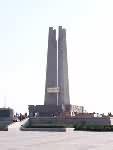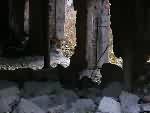- Getting around Lijiang. Dont stay in the Old Towns more than 2 days, there is nothing to do. KRISS Oct 9, 2013 05:46
- 2013 Beijing Temple Fair BENNYLAU Feb 26, 2013 03:29
- Malaysian traveling from KUL - LAX vis Shanghai PVG ZATI_DY Jan 3, 2013 20:15
Tangshan is Risen
- Views: 31304
- |Vote: 0 0
- |Add to Favorites
- |Recommend to Friends
The Phoenix
Everyone knows the legend of the phoenix – the bird that is born anew after immolation by fire. For the Hebei city of Tangshan, which now calls itself the Phoenix City, it’s a fitting metaphor for a place that has been totally resurrected from its ruins. If you’ve heard of Tangshan before, it’s almost certainly in connection with the great earthquake of 1976 – one of China’s worst natural disasters in modern history. Tangshan was flattened in just sixteen seconds in a shock that killed a quarter of a million people. After 30 years, however, the city is entirely renewed and is a quiet, pleasant town that has shaken off its ashes and has long since resolved to make every effort towards creating new prosperity, a mission that has now largely been achieved.
I was invited to Tangshan by a colleague who needed to attend to some business matters in his home town, and was grateful to have the opportunity to see the place at last. I’d known of Tangshan for a long time, since many years ago in New Zealand when a close friend of mine told me of her memories of the quake from her childhood. She remembered the panic, and being hidden in a bathtub in the chaos of the dawn aftermath. Several trains to the Northeast pass through Tangshan, and when I’d seen the city before from my train windows, it had always struck me as a lonely, quiet place, a small town far away from the bustle of the big cities nearby.
Direct trains to Tangshan going from or via Beijing follow wacky timetables, and none of them get there as quickly as a direct bus. They leave every twenty minutes or so from a side street opposite the Beijing Railway Station. If you’re intending to travel to Tangshan by bus, ask a tout in the station forecourt to lead you there – they’ll take you for free because they get a commission from the driver for finding you as a passenger - and the cost is just 50 yuan per ticket. The bus takes a speedway all the way there and the trip takes only a couple of hours.
The bus stops at the main train station in the west of the city, and we were met - and in typical Chinese fashion, taken immediately to a good restaurant - a newly opened and evidently quite fashionable place called the Phoenix on Bei Xinxi Dao (North New West Road) and featuring some impressive decorations and good local food. Tangshan’s delicacy is a kind of roast chicken, similar to Peking Duck, and lunch was generous and enhanced greatly by the local brew – Tung Beer.
Tangshan's Appeal
I asked our host what attractions there are in Tangshan, and he was embarrassed to tell me that there were none, as far as he was aware. He was quite wrong – whilst in the city itself, attractions are generally limited to memorials of the earthquake and a couple of parks, outside the city around Tangshan Prefecture are some quite noteworthy attractions, many of which are almost never frequented by other foreigners.
Amongst these, one of the most interesting is the Qingdongling Eastern Qing Mausoleums, burial site of several important former Emperors of China, numerous concubines, and the famous Dowager Cixi, the woman who steered the Qing Dynasty to its final ruin. Situated less than an hour’s drive from the city in Zunhua county in Northern Tangshan, the complex is about 350 years old and a fine example of period architecture.
Another compelling attraction is the Great Wall at Xifengkou – a rough section of the wall comparable to Simatai and featuring a connected three-gateway passway. It’s not the only place where the Great Wall can be visited – the Wall makes up the entire Northern Border of Tangshan – and at places it’s possible to spend the entire day exploring the Great Wall without seeing any foreigners, let alone any other tourists at all.
Tangshan is a port city, and a nice place to examine the natural shores of the Bohai Gulf. In Tangshan’s southeastern Leting County, boats can be hired to visit a few of the numerous attractive small islands off the coastline. Leting County is also host to a small museum dedicated to Chinese hero Li Dazhao – built in his original courtyard-style homestead.
Of course, it’s the earthquake memorial sites that receive the most visitors, and these are all within the city centre itself. The main memorial obelisk is situated in Li Zhao Park right in the main commercial area at XInhua Xidao, next to the Earthquake Memorial Hall.
July 28, 1976, 3.42 a.m.
I visited the monument to the earthquake in the early afternoon on a chilly, cool day. In the centre of a large, bare public square, the memorial seemed to me to be fairly typical of the towering, blocky monuments I’d seen in other parts of China with Socialist themes. The angular figures in the base artwork depicted perspectives from the disaster, but also many from the reconstruction efforts in the period following the earthquake. The emphasis of the memorial seemed to be in the success of the Socialist administration of Tangshan in not only recovering from the catastrophe, but also building a new economic base for the city to thrive on as it took on its new shape. The museum next to the tower echoed and elaborated on this theme.
The ‘Kang Zhen Jinian Guan’, or Earthquake Resistance Memorial Museum (ticket price: 5 yuan), is divided into several areas, each looking at the disaster from different aspects. As I wandered around the exhibits, I noticed that the displays directly related to the quake were largely outnumbered by the exhibits proclaiming the successes of the recovery. Those sections were interesting in their own right, but tended to come off as a little too self-laudatory for a museum.
The quake exhibits were certainly sobering, however. According to the story, the earthquake struck at 3.42am whilst the city was sleeping – several broken clocks on display are frozen at the exact time they were stopped – and hit at a magnitude of 7.8 on the Richter scale. An elderly woman I spoke to told me she remembered awaking with her family to find ‘their roof on their heads’ - and that when they cleared the rubble, they saw that the entire city had been erased – and a picture in the museum shows a view from above in which it can be seen clearly that the whole town had been knocked flat. Corpses were everywhere beneath the debris and as the survivors walked around the ruins, stepping on the bodies of the deceased was unavoidable. The quake affected areas as far away as Beijing, where the Dagoba in Beihai Park was damaged, and was felt much farther inland than that.
The rest of the displays seemed devoted to testimonials on Tangshan’s key businesses. The porcelain exhibits are surprisingly extensive, given that Tangshan is one of the country’s major Chinaware manufacturing zones, earning itself the title of ‘Ci Du’ – the ceramics capital. The soil around Tangshan is rich in minerals, which means that local mining initiatives are lucrative businesses. We walked past displays for industries in cement, steel, soda, salt, coal, and oil. Tangshan also produces many finished goods - a plant given pride of place manufactured train carriages. It’s not all as successful as it sounds, however – my colleague pointed out the numerous firms amongst those on display that had failed since the museum was built. Furthermore, as is typical amongst the rich and powerful the world over, money can have corruptive and disastrous consequences. The son of the leading Soda factory’s CEO was killed in New Zealand by speeding and crashing a car that his father had bought him two days before, which he was unlicensed to drive.
We took a stroll around Li Dazhao Park, a very peaceful and quiet reserve that is now free for all visitors, encircled with walkways and waterways and tranquil spots to relax. Moving on from the park, I came to realize that the whole town had the same feeling – driving along those silent streets, I began to see Tangshan not so much as a freshly reborn, thriving city, but as a calm, wizened old town that had seen great tragedy and didn’t care to attract any further trouble.
There is one more Earthquake memorial site that’s worth seeing. Hidden in the Hebei University of Engineering, and fenced off from the new campus buildings is a small area that has been left untouched since the quake hit. The old library still remains, great concrete walls shattered, wreckage piled up to the few floors that precariously still hang on their cracked supports. The force that brought this complex down is written clearly on its ruins, and I mentioned to my colleague that it must be regarded as something of a shrine to the lives lost. To my surprise, he laughed. The university ruins, he told me, with its protective fence, dark corners and shady elevated platforms, is well-known by locals to be the favourite secret place of daring university students to make love. Thus, in a city once destroyed and that now breathes again is celebrated that which has been won back.
Life.






 Copyright © 1998-2025 All rights reserved.
Copyright © 1998-2025 All rights reserved.
1.
Jan 6, 2006 04:34 Reply
MISHEN said:
Good idea Susannah - I promise you I'll right an article about the Eastern Qing tombs and Xifengkou / Panjiakou Great Wall sometime soon.
2.
Jan 5, 2006 04:43 Reply
SUSANNAH said:
A good article about the small but absolutely 'famous'city! However, I do hope there is someone who will discovery more beauty and stories of the city not about the earthquake. The reasons are that it might be somebody's lifelong pain or it has been talked about too much...Maybe we need another 30 years.
3.
Dec 20, 2005 22:28 Reply
SOPHIA08 said:
Da Zhao Park, not Li Zhao Park, it derived its name from the martyr and hero Li Dazhao
4.
Dec 15, 2005 08:59 Reply
JABAROOTOO said:
One of the first books I read after arriving in China was a collection of stories written by Xin Ran titled 'The Good Women of China'.
One of the stories 'The Mothers who endured an Earthquake' was the saddest and most heart-breaking story about the short-term and long-term survivors of Tangshan's Quake.
It's good to revisit through another's eyes and see how new life has risen from the rubble and the pain.